Why is this happening?
The causes of childhood aggression are as follows:
Heredity
There are calm children who can be left for a couple of hours with a construction set and go about their business. But there are babies who require constant attention. Their mood changes at the speed of sound, and they can get angry, cry, break toys, and hit other children.
The child's psyche is still very sensitive. And if one of the relatives was too eccentric, then this could be inherited.

Temperament
Cholerics quickly “flare up” and also quickly calm down. It is difficult for such people to control their emotions even as adults, let alone as children.

As an adult, a person will not change completely, but if from childhood you teach him self-control and managing his anger, in the future it will become easier for him to establish relationships with people.
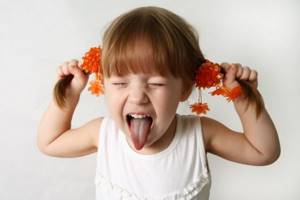
Upbringing
The generation of modern parents is trying to give their children all the best that their mothers and fathers did not give them. Those whose childhood was in the harsh 90s still remember the restrictions on sweets.
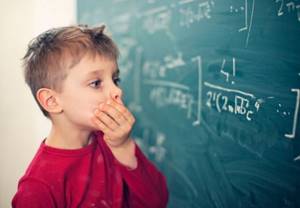
And also things that were bought at the market, bans on entertainment, because there was no money. And I want everything to be different for the child. Spoiled children often behave aggressively, getting used to having their every request satisfied.
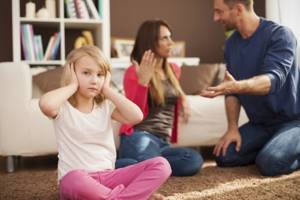
Mental problems
Some diseases appear several years after the birth of the child. And aggression can be a symptom of a mental disorder.
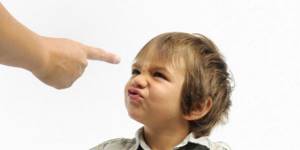
Psychotrauma
If a child is frightened by something, he can experience this fear, splashing out emotions on others.
Imitation
If a child has before his eyes an example of how the parents of his friends are trying to eliminate the consequences of childhood aggression with the help of expensive gifts, he will behave in a similar way, trying to influence his relatives.

Jealousy
When a baby appears in the family, the older child feels abandoned and tries to attract attention with tantrums, damage to objects, bad grades, and conflicts with friends.
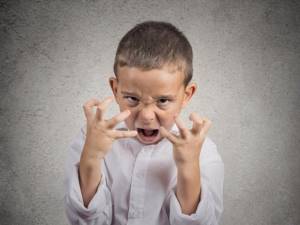
Critical age
Many parents are waiting with a shudder for that very “3-5 year crisis” that psychologists talk about. At this time, the baby is developing as a personality and strives for independence. Any help or advice is perceived as hostile. Moreover, the baby can treat people differently.
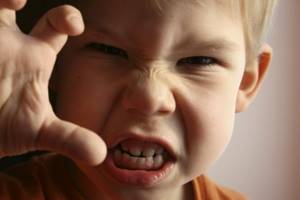
For example, aggression in kindergarten does not necessarily guarantee that the child will also have problems at home - he may behave normally. Also, children often react differently to relatives and even strangers.

Aggression in adolescents, presentation for a lesson on the topic
Slide 1
AGGRESSION IN ADOLESCENTS The presentation was prepared by: teacher-psychologist GBOU secondary school No. 369 Makarova I. N.
Slide 2
Aggression is destructive behavior that contradicts the norms and rules of the existence of people in society, causing physical and moral harm to people, or causing them psychological discomfort.
Slide 3
Adolescent aggression is one of the most typical manifestations of the teenage crisis. Teenage aggression is an extremely unpleasant, but at the same time natural and natural phenomenon. Teenage aggression is a sign of internal discomfort and inability to control one’s emotions.
Slide 4
What are the main forms of adolescent aggression? Physical aggression: The teenager uses physical force against other people. Verbal aggression: a teenager expresses his negative feelings using words, threats, shouting, etc. Irritability: the teenager is rude at the slightest provocation, becomes abrupt and hot-tempered. Suspiciousness: the teenager has a negative attitude towards others, does not trust them, believing that “everyone is against him.” Indirect aggression: a teenager tries to express his aggression, aimed at someone specific, through other people (wicked jokes, gossip, bullying). Resentment: a teenager can be offended at the slightest reason, and the resentment can be directed at a specific person (peer or adult) or “at the whole world.” Passive-aggressive behavior (hidden aggression): a teenager does not do what is asked, or does it too slowly, forgets about requests and instructions, and delays time.
Slide 6
Recommendations for parents The most important thing is to create for the child such living conditions where he would be shown examples of peaceful relationships between people and there would be no negative examples of aggressive behavior. Education on the principles of cooperation (especially in the family) is the main condition for preventing aggression. The best guarantee of good self-control and adequate behavior in children is the ability of parents to control themselves. The table below provides general “recipes” for getting rid of anger that will be useful to all parents.
Slide 7
Contents How to do it 1. Build a relationship with your child so that he feels calm and confident with you - Listen to your child; - spend as much time as possible with him; - share your experience with him; - tell him about your childhood, victories and failures; - if there are several children in the family, try to communicate not only with everyone together, but also give your “undivided” attention to each of them separately 2. Watch yourself, especially in those moments when you are under stress and it is easy to get out of your mind balance - Put off doing things together with your child; - try not to touch the child in moments of irritation
Slide 8
Contents Ways to do it 3. If you are upset, then children should know about your condition - Tell children directly about your feelings, desires, needs: “I am very upset, I want to be alone. Please play in the next room.” 4. In those moments when you are upset or angry, do something pleasant for yourself that could calm you down - Take a warm bath, shower; - drink tea; - listen to your favorite music
Slide 9
Contents How to do it 5. Try to anticipate and prevent possible troubles that may cause your anger - Do not let your child play with the things that you value; - do not allow yourself to be thrown off balance; learn to anticipate the onset of your own emotional breakdown and prevent it by managing yourself and the situation 6 . You should prepare for some particularly important events in advance - study the strengths and capabilities of your child; - if you have to make a first visit (to the doctor, to kindergarten, to school), rehearse everything in advance
Slide 10
Practical recommendations for parents and teachers
Slide 11
How to behave correctly with children who show aggression towards adults or peers. Calm attitude in case of minor aggression. In cases where the aggression of children and adolescents is harmless and understandable, the following positive strategies can be used: - completely ignoring the child/adolescent’s reactions (a very powerful way to stop unwanted behavior); - an expression of understanding of the child’s feelings (“Of course, you’re offended, but...”); - switching attention, suggesting some task (“Please help me get the dishes from the top shelf, you’re taller than me”); - a positive designation of behavior (“You’re angry because you’re tired”).
Slide 12
How to behave correctly with children who show aggression towards adults or peers. Focusing on actions (behavior), rather than on the individual. The technique of objective description of behavior allows us to draw a clear boundary between an act and a personality. After the child has calmed down, it is advisable to discuss his behavior with him. It should be described how he behaved during the manifestation of aggression, what words he said, what actions he performed, without giving any assessment. Critical statements, especially emotional ones, cause irritation and protest and lead away from solving the problem.
Slide 13
How to behave correctly with children who show aggression towards adults or peers. Control over your own negative emotions. Parents and professionals need to very carefully control their negative emotions when interacting with aggressive children. When a child or teenager demonstrates aggressive behavior, it causes strong negative emotions in adults - irritation, anger, resentment, fear or helplessness. Adults need to recognize the normality and naturalness of these negative experiences, understand the nature, strength and duration of the prevailing feelings.
Slide 14
Reduce the tension of the situation. Typical incorrect actions of an adult that increase tension and aggression are: - raising the voice, changing the tone to a threatening one; — demonstration of power (“I am still the teacher here”, “It will be as I say”); - cry, indignation; - aggressive postures and gestures: clenched jaws, crossed or clasped hands, talking “through clenched teeth”; - sarcasm, ridicule, ridicule and mimicry; - negative assessment of the personality of the child, his relatives or friends; - use of physical force; - drawing strangers into the conflict; - unyielding insistence on being right; - notations, sermons, “reading morals”; - punishment or threats of punishment; - generalizations such as: “You are all the same”, “You, as always, ...”, “You never ...”; - comparing the child with other children (not in his favor); — commands, strict requirements, pressure; - excuses, bribery, rewards.
Slide 15
How to behave correctly with children who show aggression towards adults or peers. Discussion of misconduct. There is no need to analyze behavior at the moment of manifestation of aggression; this should be done only after the situation has been resolved and everyone has calmed down. At the same time, a discussion of the incident must be held as soon as possible. It is better to do this in private, without witnesses, and only then discuss it in a group or family (and even then not always). It is important to remain calm and objective during the conversation. It is necessary to discuss in detail the negative consequences of aggressive behavior, its destructiveness not only for others, but, above all, for the smallest aggressor.
Slide 16
How to behave correctly with children who show aggression towards adults or peers. Maintaining a child's positive reputation. It is very difficult for a child, especially a teenager, to admit that he is wrong and defeated. The worst thing for him is public condemnation and negative evaluation. Children and adolescents try to avoid this at all costs, using various mechanisms of protective behavior. Indeed, a bad reputation and a negative label are dangerous: once attached to a child/teenager, they become an independent motivating force for his aggressive behavior. To maintain a positive reputation, it is advisable to: - publicly minimize the teenager’s guilt (“You don’t feel well,” “You didn’t want to offend him”), but show the truth in a face-to-face conversation; - do not demand complete submission, allow the teenager/child to fulfill your demand in his own way; — offer the child/adolescent a compromise, an agreement with mutual concessions. Insisting on complete submission (that is, on the child not only immediately doing what you want, but also in the way you want), can provoke a new outburst of aggression.
Slide 17
How to behave correctly with children who show aggression towards adults or peers. Demonstration of a model of non-aggressive behavior. An important condition for developing “controlled aggression” in a child is demonstrating models of non-aggressive behavior. When aggression occurs, both sides lose their composure, and a dilemma arises - to fight for their power or to resolve the situation peacefully. Adults need to behave non-aggressively, and the younger the child is, the more peaceful the adult’s behavior should be in response to children’s aggressive reactions. The behavior of an adult, which allows one to demonstrate an example of constructive behavior and aimed at reducing tension in a conflict situation, includes the following techniques:
Slide 18
unreflective listening. This is listening without analysis, giving the interlocutor the opportunity to speak. It consists of the ability to be silent attentively. Both words are important here. To remain silent - because the interlocutor wants to be heard, and is least of all interested in our comments; carefully - otherwise the person will be offended, and communication will be interrupted or turn into a conflict. All you need to do is support the flow of the interlocutor’s speech, trying to get him to speak out completely; pause, giving the child the opportunity to calm down; instilling calm through non-verbal means; clarifying the situation using leading questions; use of humor; acknowledgment of the child's feelings. Children quickly adopt non-aggressive behavior patterns. The main condition is the sincerity of the adult, the correspondence of his non-verbal reactions to the words.
Slide 19
Types of aggression in children and ways to build relationships
Slide 20
Name of the type of aggression Recommendations Hyperactive-aggressive child Such children, being brought up in a family of the “idol” type or in an atmosphere of permissiveness, when they find themselves in a group of peers, can become aggressive. It is necessary to competently build a system of restrictions, including using game situations with rules. Encourage children to admit their own mistakes. Teach them not to blame others. Develop a sense of empathy, sympathy for others - peers, adults and all living things. Aggressive, touchy and exhausted child. A child’s touchiness can be associated not only with shortcomings in upbringing or learning difficulties, but also with growing pains, peculiarities of maturation of the nervous system and body. Increased sensitivity, irritability, and vulnerability can provoke aggressive behavior. Help your child relieve mental stress by playing with him in a noisy game. And try to avoid stressful situations if the child is almost always aggressive
Slide 21
Name of the type of aggression Recommendations Aggressive child with oppositional defiant behavior. If a child is often rude, but not to everyone, but only to parents and people he knows, then there is probably something wrong in your relationship. You rarely engage and communicate with your child; you are no longer the role model you used to be; the child is bored, has nothing to do, and he transfers his own mood and problems onto you, shifts responsibility for his behavior. Try to solve problems together, in cooperation with the child, but not for him. Aggressive-fearful child. Hostility and suspicion can be a means of protecting a child from an imaginary threat, an “attack.” Work with fears, model, that is, create, a dangerous situation and overcome it together with the child.; in this case, the situation should be on the verge of pleasant and unpleasant with a predominance of pleasant
Slide 22
Name of the type of aggression Recommendations Aggressive-insensitive child. There are children whose ability to respond emotionally, empathize, and sympathize with others is impaired. The reasons may be unfavorable conditions of family upbringing, impaired intellectual development of the child, as well as traits of emotional coldness, callousness, flatness, increased affective (emotional) excitability, which are transmitted from the parents or relatives of the child. At the same time, it is difficult for him to understand that the other, that is, the offended, is feeling bad and in pain. Try to stimulate humane feelings in such a child: be kind, pet cats and dogs, care for animals; draw the child's attention to the sad, depressed state of another person and stimulate the desire to help. If this does not help, teach your child to take responsibility - to “work off” for his aggressive behavior (“Now go and apologize”, “Stroke him on the head”, “Shake hands”, “Offer a toy to the child who is offended by you”, etc.)
Slide 23
Thank you for your attention!
Slide 24
Internet information resources: https://www.psihologu.info /








